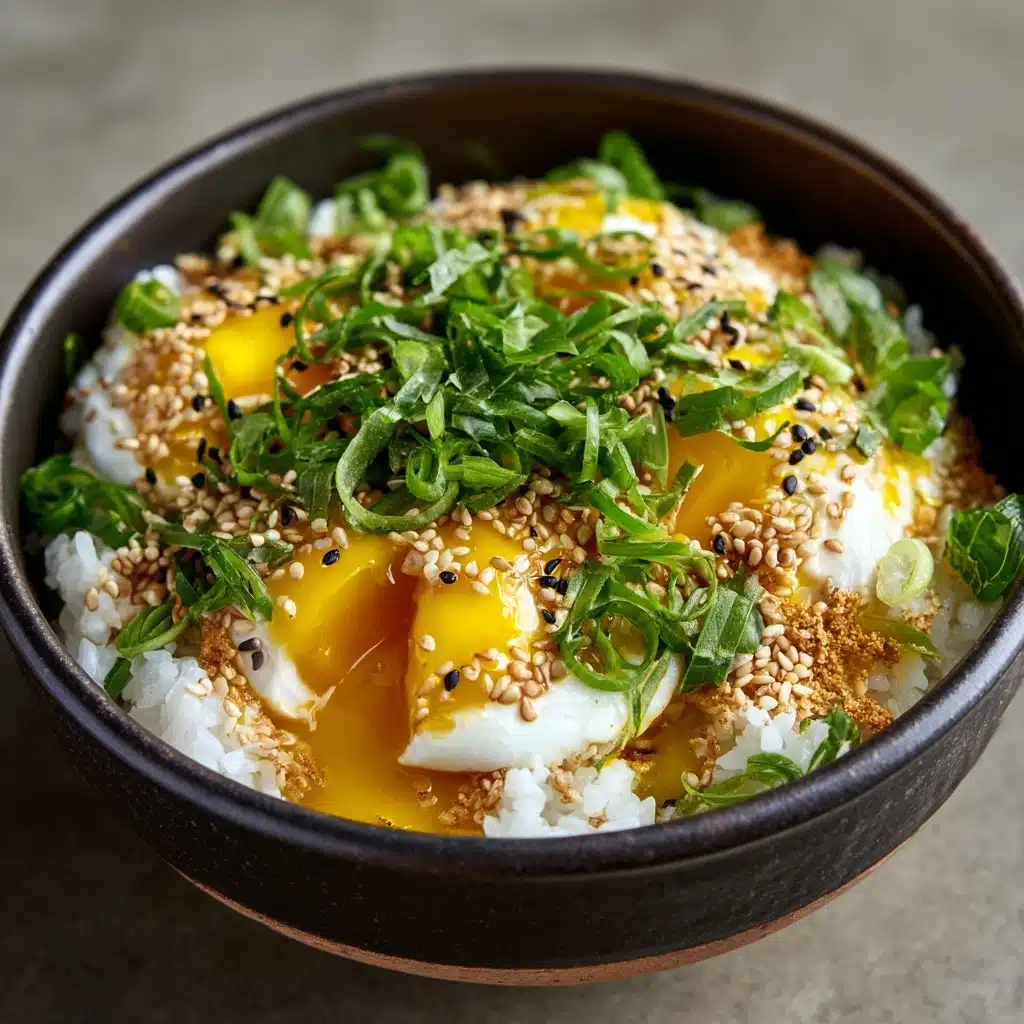Korean Steamed Eggs Recipe
There’s nothing quite as heartwarming as digging into a bowl of Korean Steamed Eggs—those irresistibly fluffy, custardy clouds that arrive at the table still gently jiggling. This dish, known as gyeran jjim, is more than just eggs: it’s a soothing staple in Korean home kitchens, coming together with just a handful of humble ingredients. Whether you serve it as a side dish to a spicy meal or enjoy it solo with a bowl of rice, Korean Steamed Eggs bring buttery richness and delicate flavor that make every bite feel like a warm hug.

Ingredients You’ll Need
The magic of Korean Steamed Eggs is in its simplicity—each ingredient has a clear purpose, layering flavor and contributing to the dish’s distinctively soft, soufflé-like texture. Start with top-quality eggs, and you’re already halfway to greatness!
- Eggs: The core of this dish; use the freshest large eggs you can find for that signature creamy texture.
- Water or Unsalted Chicken Broth: Water will yield a pure, eggy flavor, while broth adds savory depth. Choose what fits your mood!
- Salt: Just a pinch enhances the natural flavor of the eggs—don’t skip it.
- Black Pepper: Adds a hint of gentle warmth and a slight peppery bite to the custard.
- Sesame Oil: This finishing touch offers a nutty fragrance and rich aftertaste that’s absolutely classic in Korean Steamed Eggs.
- Green Onion: Brings freshness, color, and just a kiss of onion flavor to wake up the palate.
- Optional Garnish (Toasted Sesame Seeds, Extra Green Onion): A sprinkle of toasted seeds or an extra flourish of green creates visual appeal and crunch.
How to Make Korean Steamed Eggs
Step 1: Whisk the Eggs and Liquid
In a heatproof bowl that fits easily in your steamer or pot, crack in the eggs, pour in your water or broth, and add the salt and pepper. Grab a whisk and beat everything together until the mixture is silky-smooth and all the yolks are evenly incorporated—no visible streaks allowed! If you want your Korean Steamed Eggs to have the ultimate creamy consistency, you can strain the egg mixture through a fine mesh sieve before the next step.
Step 2: Steam the Custard
Fill your steamer or a large pot with about one inch of water and bring it to a simmer. Place the bowl with your egg mixture inside—if you’re using a pot, set the bowl on a rack so it’s above the water, not submerged. Cover tightly with a lid to trap the steam, then let the eggs cook gently over medium-low heat for 10 to 12 minutes. The Korean Steamed Eggs are ready when they’re just set but still quiver softly, like a wobbly pudding.
Step 3: Finish with Sesame Oil and Green Onion
Once the custard is set, carefully remove the hot bowl from the steamer (use oven mitts!). Drizzle the sesame oil over the top to infuse every spoonful with that signature nutty aroma. Sprinkle on the sliced green onion—and if you like, add a pinch of toasted sesame seeds for a bit of crunch and a beautiful finish.
Step 4: Serve Immediately
Korean Steamed Eggs are at their most magical when served piping hot, straight from the bowl. The texture will be soft, light, and almost soufflé-like—perfect for scooping onto a bowl of fluffy rice or eating as is for a gentle, comforting snack.
How to Serve Korean Steamed Eggs

Garnishes
Presentation is everything with Korean Steamed Eggs, and a few thoughtful garnishes go a long way! A generous sprinkle of chopped green onion not only makes the custard look fresh and inviting but also brings a subtle brightness that balances the richness. Toasted sesame seeds add visual appeal and a subtle crunch that contrasts beautifully with the delicate eggs. Feel free to play with shaved chili or a drop of soy sauce if you’re feeling adventurous.
Side Dishes
Korean Steamed Eggs are wonderfully versatile, working alongside nearly any main dish. Traditionally, they shine as a side for bold, spicy Korean stews like kimchi jjigae or spicy pork bulgogi, their soothing texture offering relief from spicier flavors. They’re also lovely as part of a simple home-cooked spread—pair with milder veggie banchan, steamed rice, and maybe a handful of pickled radishes for a well-rounded, comforting meal.
Creative Ways to Present
If you’re hosting or just want to add a special touch, try making individual portions of Korean Steamed Eggs in small ramekins or tea bowls—perfect for brunch or dinner parties. You can also experiment by folding in small bits of soft tofu, steamed seafood, or diced vegetables before steaming for extra flavor and color. No matter how you serve it, feel free to get creative with your garnishes for a beautiful table presentation.
Make Ahead and Storage
Storing Leftovers
If you have any leftover Korean Steamed Eggs, let them cool to room temperature before transferring to an airtight container. They’ll keep nicely in the fridge for up to 2 days, although the texture may firm up a bit as they sit. Be sure to handle gently so the custard stays intact.
Freezing
Freezing isn’t recommended for this dish, as the delicate custard can break down and become watery after thawing. Korean Steamed Eggs are truly best enjoyed fresh, but if you absolutely need to freeze them, use a freezer-safe container and eat within one month, knowing the texture will change.
Reheating
To reheat Korean Steamed Eggs without drying them out, place them in a heatproof dish and steam gently for a few minutes or microwave in short bursts (about 20 seconds at a time) until just heated through. Add a drop of extra sesame oil and more fresh green onion to refresh the flavors before serving.
FAQs
How do I make sure my Korean Steamed Eggs come out super fluffy?
The secret to the fluffiest Korean Steamed Eggs is gentle, even steaming and not overcooking. Whisk the egg mixture thoroughly to incorporate air, and keep the heat steady on medium-low. Straining the egg mixture before steaming also helps create a smooth, airy texture you’ll love.
Can I use broth instead of water? What kind works best?
Absolutely! Unsalted chicken broth (or even vegetable broth) infuses the eggs with savory depth and makes every spoonful more complex. Broth can be substituted for water in a 1:1 ratio—just make sure it’s not too salty, since you’ll be seasoning the eggs, too.
Can I make Korean Steamed Eggs in the microwave?
Yes, you can microwave Korean Steamed Eggs for a speedy alternative. Use a microwave-safe bowl, cover loosely with plastic wrap, and cook at medium power in one-minute intervals, stirring gently between each burst, until softly set. Watch carefully so they don’t overcook!
What should I do if my eggs turn out watery or tough?
If your steamed eggs are watery, it’s likely they were overcooked or steamed at too high a temperature, causing the proteins to separate. For tough eggs, reduce the cooking time and steam more gently—the goal is a barely-set, custard-like consistency. Practice makes perfect, so don’t be discouraged.
Are Korean Steamed Eggs gluten-free or vegetarian?
Yes, Korean Steamed Eggs are naturally gluten-free and vegetarian when made with water or vegetable broth. For extra peace of mind, always check your broth ingredients to be sure no wheat or animal products are sneaking in.
Final Thoughts
If you’ve never experienced the comfort of Korean Steamed Eggs, you’re in for a real treat—each spoonful is as cozy and satisfying as a warm embrace. Give this recipe a go next time you want something wholesome and nourishing, and don’t be surprised if it quickly becomes a staple at your table.
Print
Korean Steamed Eggs Recipe
- Total Time: 17 minutes
- Yield: 2–3 servings 1x
- Diet: Non-Vegetarian
Description
Learn how to make delicious Korean steamed eggs, a fluffy and flavorful side dish that pairs perfectly with rice. This simple recipe is easy to prepare and will impress your family and friends with its light texture and savory taste.
Ingredients
Main Ingredients:
- 4 large eggs
- 1 cup water or unsalted chicken broth
- 1/4 teaspoon salt
- 1/8 teaspoon black pepper
Additional Ingredients:
- 1 teaspoon sesame oil
- 1 green onion, finely chopped
- Optional garnish: toasted sesame seeds, additional sliced green onion
Instructions
- Prepare the Egg Mixture: In a heatproof bowl, whisk together eggs, water or broth, salt, and pepper until smooth.
- Steam the Eggs: Place the bowl in a steamer or pot with simmering water, cover, and steam for 10–12 minutes until just set.
- Finish and Serve: Drizzle with sesame oil, sprinkle with green onions, and garnish with sesame seeds. Serve hot with rice.
Notes
- For a creamier texture, strain the egg mixture before steaming.
- You can also microwave the eggs in 1-minute intervals until softly set.
- Prep Time: 5 minutes
- Cook Time: 12 minutes
- Category: Side Dish
- Method: Steaming
- Cuisine: Korean
Nutrition
- Serving Size: 1 portion
- Calories: 110
- Sugar: 0 g
- Sodium: 320 mg
- Fat: 8 g
- Saturated Fat: 2 g
- Unsaturated Fat: 5 g
- Trans Fat: 0 g
- Carbohydrates: 1 g
- Fiber: 0 g
- Protein: 8 g
- Cholesterol: 215 mg






